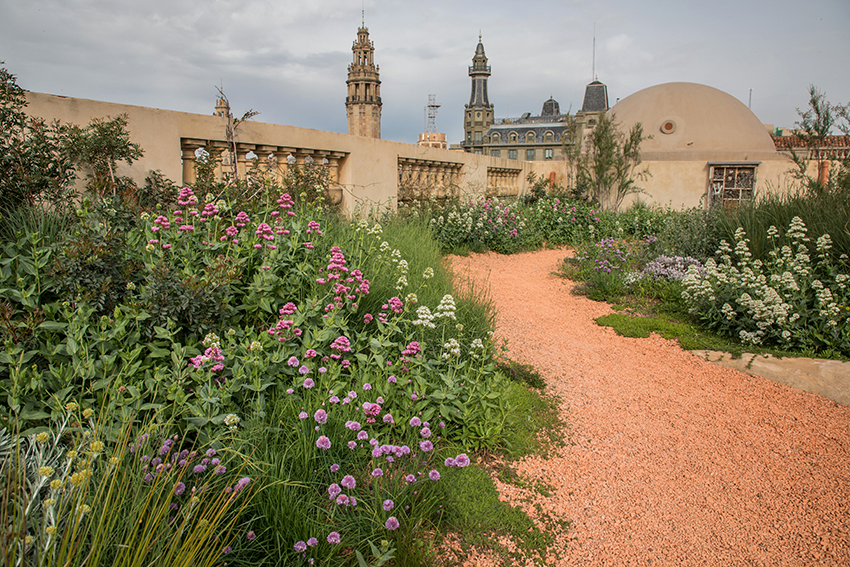The BIG4LIFE project will work on eight green roofs and facades of buildings in Lleida and Barcelona applying the xeriscaping concept, which optimizes the use of water in these spaces.
BIG4LIFE will consider environmental, social and economic benefits of building-integrated green systems to determine their cost-efficiency.
The project has three years to co-design and implement strategic maintenance, monitoring, and impact assessment of these systems.
Being in contact with nature brings a multitude of physical and psychological benefits: it lowers blood pressure, reduces the risk of diabetes, asthma, allergies, and cardiovascular diseases while improving our mental health and life expectancy. A growing number of scientific studies show that nature brings us many benefits, but how can we bring nature closer to urban areas?
Building Integrated greenery (BIG) systems, i.e., green roofs and facades, can help achieve these health benefits for people living in urban environments. For this reason, the BIG4LIFE project, which held its kick off meeting at the University of Lleida on October 26 and 27, aims to promote the renaturalization of the urban environment through BIG systems.

Framed in the New European Bauhaus movement, the BIG4LIFE project aims to promote the transition of the construction sector towards a more sustainable, circular, toxic-free, energy-efficient, and climate-resilient model. With a budget of 1.8 million euros, this LIFE project has three years to achieve the co-design of framework plans for maintenance, monitoring, and impact assessment of building integrated greening (BIG) systems and implement so that this can be verified in the demanding conditions of the Mediterranean climate.
The objective is to apply the xeriscaping concept of creating green roofs that require little or no irrigation and maintenance. With this strategy, the plant species to be planted in green roofs are selected according to their water needs and their adaptation to environmental conditions, to optimize water use.
The BIG4LIFE project aims to demonstrate that by applying this approach, using collaborative networks (among the multiple agents involved in their management), and with the support of appropriate intelligent solutions, both the long-term viability of BIG systems and their positive lifespan are feasible. Thus, the BIG4LIFE research team will work to improve the ecosystem services offered by these green roofs to achieve the sustainability of this type of systems.
The project is based on the creation of networks at the building level, in which the different stakeholders are integrated, such as direct and indirect users, managers and owners, building maintenance teams and external maintenance companies, among others. The project aims to demonstrate that with efficient management of the tasks and roles assigned to these stakeholders, complemented by external assistance through a service-learning program, it is possible to maintain the green roof and green façade systems over time, ensuring that the provision of benefits is maintained on an ongoing basis.

In the initial phase of the project, the technical team will work on the preparation and rehabilitation of the green roofs and on the training of the people involved in the management and maintenance of the project’s BIG systems. Once the preliminary phase has been completed, the two-year monitoring of the green roofs will begin, in order to determine the factors involved in the good (or not) functioning of the systems. At the end of the monitoring phase, a report on the environmental performance of each of the eight projects will be carried out.
BIG4LIFE will analyze the current conditions of eight existing building-integrated greening (BIG) projects located in Lleida and Barcelona – three of which failed, and for which the project will assume their refurbishment. For the analysis of the BIG systems, 13 ecosystem services will be monitored for two years (from biodiversity to human well-being, including energy savings and efficient water use or improved air quality, among others). The methodologies used will combine technologies (such as photo-trapping cameras to detect wildlife, and various sensors) with questionnaires involving citizen participation (within the framework of Community Service Learning). Students and people at risk of social exclusion will contribute to the maintenance and monitoring of green roofs.
The evaluation of building-integrated green systems will make it possible to calculate their cost-efficiency (the ratio between the benefits obtained and the cost of creating and maintaining them). This makes it possible to compare their advantages to other building solutions. “This evaluation and improvement of the positive lifespan of BIG systems makes it possible to calculate their profitability and feasibility to be subsequently incorporated into local and national policies and standards,” explains Gabriel Perez, professor at the University of Lleida and coordinator of the project.
“The BIG4LIFE project wants to contribute to the New European Bauhaus initiative by reducing the environmental impacts of new and refurbished buildings, creating circular value chains to boost urban economies while bringing about urban and territorial regeneration, as well as improving the well-being of citizens, and supporting biodiversity in the urban environment,” Perez continues.
Coordinated by the University of Lleida, the consortium that forms the project includes eight other European partners (Spain, Italy, the Netherlands, and Greece) from academia and business: the Forest Science and Technology Centre of Catalonia (CTFC), the University of Studies of Genoa (UNIGE), the Hellenic Open University (HOU), TEB Verd SCCL, Verdtical Ecosistema, Sempergreeen BV, and Eixverd Solutions.
The ultimate goal of BIG4LIFE is, on the one hand, to incorporate the world of BIG into public policies and professional regulations, and on the other hand, to replicate in other cities on an international scale the strategies developed, and lessons learned in the eight pilot rooftops in Barcelona and Lleida.



Hi, this is a comment.
To get started with moderating, editing, and deleting comments, please visit the Comments screen in the dashboard.
Commenter avatars come from Gravatar.